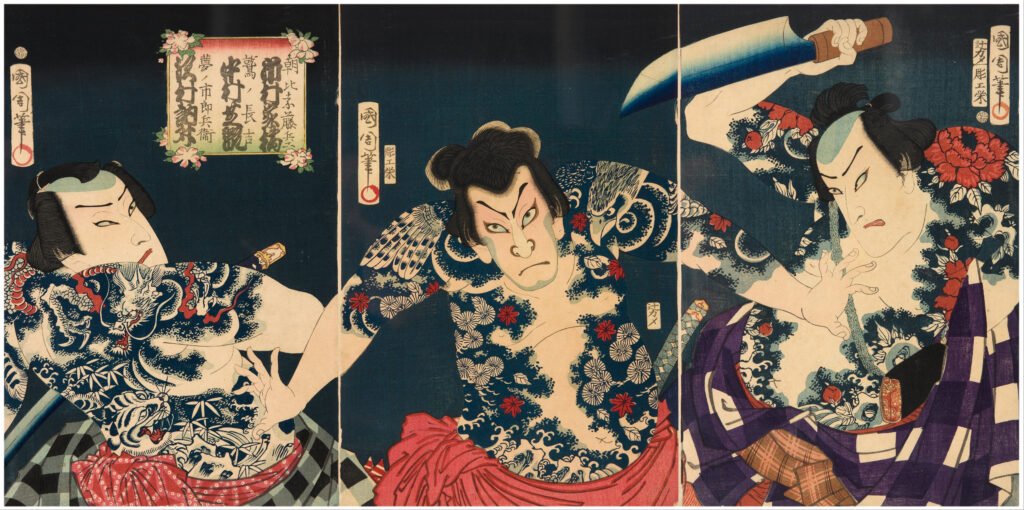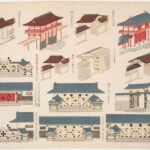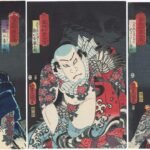In our previous article, “Japanese Traditional Tattoo: The Stunning Legacy of Ukiyo-e That Brought Irezumi to Life,” we explored the profound connection between Japanese woodblock prints and tattoo culture. Building upon that foundation, this second installment in our “Japanese Traditional Tattoo and Ukiyo-e” series focuses on the revolutionary artist who single-handedly transformed both art forms: Utagawa Kuniyoshi (歌川国芳, 1798-1861). His groundbreaking “Water Margin” series didn’t just influence tattoo design—it created an entirely new artistic paradigm that continues to define Japanese tattoo culture today.
The Pre-Kuniyoshi Era of Japanese Tattoos
Before Kuniyoshi revolutionized the art form, Japanese tattoos—then called “horimono” (彫り物)—existed in a vastly different cultural context. According to the essay collection “Shodō Kikimimi Seken-zaru” (諸道聞耳世間猿) from the early Meiwa period (1764-65), tattoos of this era were primarily intimidation tools featuring dragons, Fudō Myō-ō (the fierce Buddhist deity), hannya masks (demonic female faces from Noh theater), and severed heads. These designs served practical purposes: marking criminals, intimidating rivals, or sealing romantic vows.
The practice was particularly popular among the lower classes of Edo society—firefighters known as “hikeshi” (火消し), palanquin bearers, and members of the yakuza underworld. For these marginalized groups, tattoos represented a form of rebellion against the rigid Confucian social order that dominated Tokugawa Japan. The act of permanently marking one’s body was considered a desecration of the flesh given by one’s parents, making it a profound act of defiance.
Kuniyoshi’s Journey from Obscurity to Fame
Utagawa Kuniyoshi’s path to becoming the father of modern Japanese tattoo art was far from straightforward. Born as the son of a silk-dyer in Kyoto, he showed exceptional artistic talent from childhood. At age twelve, his “Shōki Wielding a Sword” (鐘馗提剣図) so impressed the master artist Utagawa Toyokuni that he was immediately accepted as a disciple. Despite this promising start, Kuniyoshi spent over a decade in poverty and obscurity.
By his late twenties, while contemporaries like Kunisada dominated the actor print market and Eisen ruled beauty prints, Kuniyoshi survived on menial commissions—decorating paper bags for confectioners and creating New Year’s cards. His fortunes changed dramatically when he met Umenoya Kakuju, a wealthy kyōka poet who recognized his latent genius and provided him with both patronage and accommodation.
The Water Margin: A Revolutionary Inspiration
During his stay with Kakuju, Kuniyoshi encountered the Chinese novel “Water Margin” (水滸伝, Suikoden in Japanese), which tells the story of 108 outlaws who band together at Mount Liang to fight against corrupt government officials. While earlier Japanese artists, including the great Hokusai, had illustrated versions of this tale, none had captured its raw energy and rebellious spirit as Kuniyoshi would.
The Water Margin’s appeal to Edo’s working classes was immediate and visceral. These were not stories of noble samurai or refined courtiers, but of outcasts and rebels who lived by their own code of honor. For the firefighters, construction workers, and street toughs of Edo, these Chinese brigands represented idealized versions of themselves—men who valued loyalty and justice above social convention.
The Birth of Pictorial Tattoo Art
In 1827, at age 31, Kuniyoshi published his groundbreaking series “The 108 Heroes of the Popular Water Margin” (通俗水滸伝豪傑百八人之一個) through the Kagaya publishing house in Ryōgoku. What made these prints revolutionary was not merely their dynamic composition or masterful technique, but Kuniyoshi’s decision to adorn his heroes with elaborate full-body tattoos that had never before appeared in Japanese art.
The most famous of these designs include:
- Kyūmonryū Shishin (Nine-Dragon Shi Jin): Depicted with nine dragons writhing across his exposed torso, breathing lightning as he subdues a bandit
- Rōrihakuchō Chōjun (Wave-Riding Zhang Shun): His body covered in cherry blossoms and a giant snake breathing fire
- Kaoshō Rochishin (Flower Monk Lu Zhishen): Bearing floral patterns across his massive back
These weren’t the simple, small-scale designs that had existed before. Kuniyoshi created complex, narrative compositions that transformed the human body into a living canvas. His tattoos incorporated natural elements—waves, clouds, wind, and fire—with mythological creatures and floral motifs in ways that emphasized both the beauty and the ferocity of his subjects.
The Ukiyo-e and Tattoo Connection Deepens
The success of Kuniyoshi’s Water Margin series was unprecedented. According to the essayist Mitsumura Engyo, “All the stylish men of Edo got these Water Margin tattoos.” What began as a risky venture—publishers were initially reluctant to commit to a 108-print series—became one of the most profitable enterprises in ukiyo-e history.
The influence of these ukiyo-e prints on actual tattoo practice was immediate and transformative. Firefighters and construction workers began visiting tattoo artists, called “horishi,” with Kuniyoshi’s prints in hand, demanding these exact designs be recreated on their bodies. This marked a fundamental shift in Japanese tattoo culture: from simple symbols to complex artistic narratives, from intimidation to aesthetic appreciation.
Theatrical Adoption and Cultural Legitimacy
The cultural impact of Kuniyoshi’s tattoo designs extended beyond the streets to the kabuki theater. In 1833, at the Nakamura-za theater, the actor Ichikawa Danjūrō VII appeared in “Temukaeyama Momiji no Gohei” with a Kurikara dragon tattoo based on Kuniyoshi’s design. The production was a massive success, with contemporary records noting that “this play was a great hit… taking advantage of the current fashion for Kuniyoshi’s Water Margin prints and the tattoos that Edo’s gallants were getting.”
The following year in Osaka, when the same actor performed in “Natsu Matsuri Naniwa Kagami,” he appeared with a full-back cloud and dragon tattoo—a dramatic departure from the traditionally bare-skinned costume for this role. These theatrical adoptions gave a certain cultural legitimacy to what had been considered a practice of the lower classes.
The Artistic Legacy
Kuniyoshi’s innovations in depicting tattoos through ukiyo-e established several principles that continue to define Japanese tattoo art today:
- Narrative Composition: Rather than isolated symbols, tattoos should tell stories
- Body Flow: Designs should complement and enhance the natural contours of the human body
- Dynamic Movement: Static decoration gave way to designs that seemed to live and breathe with their wearer
- Symbolic Depth: Each element carried meaning beyond mere decoration
The technical mastery Kuniyoshi displayed in these prints—the way water seemed to flow, dragons appeared to coil, and flames seemed to flicker—set a standard that tattoo artists still strive to achieve today. His use of “bokashi” (gradation) techniques in printing translated directly into the shading methods that became hallmarks of Japanese tattooing.
The Broader Cultural Revolution
What Kuniyoshi accomplished went far beyond creating beautiful pictures. He transformed the Japanese perception of tattoos from marks of criminality or lower-class bravado into legitimate artistic expression. His Water Margin heroes weren’t just decorated with tattoos—the tattoos were integral to their character, expressing their inner strength, their connection to nature, and their defiance of conventional authority.
This artistic elevation occurred despite—or perhaps because of—official prohibition. The Tokugawa government issued edicts against tattooing in 1810 and again in 1842, condemning the practice of “carving and defacing the body inherited from one’s parents.” Yet these bans only seemed to increase the popularity of tattoos among those who identified with the rebellious spirit of the Water Margin heroes.
Kuniyoshi’s Artistic Process and Innovation
The creation of 108 unique designs pushed Kuniyoshi to extraordinary creative heights. Legend has it that he frequented the Gohyaku Rakan Temple in Honjo, studying the 500 Arhat statues to find inspiration for the varied expressions and poses of his heroes. This dedication to anatomical accuracy and emotional expression set his work apart from the more stylized approaches of his contemporaries.
Unlike the Chinese original, where only three heroes (Shi Jin, Lu Zhishen, and Yan Qing) are described as having tattoos, Kuniyoshi expanded this to thirteen characters, each with unique and elaborate designs. This creative liberty demonstrated his understanding that he wasn’t merely illustrating a foreign tale but creating a new artistic vocabulary that would resonate with Japanese sensibilities.
The Economics of Revolution
The commercial success of Kuniyoshi’s Water Margin series transformed not only his own fortunes but the entire ukiyo-e industry. Publishers who had initially balked at the scale of the project found themselves reprinting the series multiple times. The Kagaya publishing house’s original 1827 edition was followed by reissues from Ibaya Sensaburō and later a medium-format edition by Yamamotoya Heikichi.
This commercial success had profound implications for the spread of tattoo culture. As prints became more widely available and affordable, the designs reached beyond Edo to influence tattoo practices throughout Japan. The standardization of these images through mass printing meant that someone in Osaka could have the same Nine-Dragon tattoo as someone in Edo, creating a shared visual language of rebellion and artistry.
International Recognition and Modern Legacy
Today, when the world speaks of “irezumi”—using the Japanese word as the global term for Japanese-style tattoos—they are referring to an art form that Kuniyoshi essentially created. The principles he established through his ukiyo-e prints—large-scale body suits, narrative themes, the integration of natural and mythological elements—remain the defining characteristics of Japanese tattooing.
Modern tattoo artists worldwide study Kuniyoshi’s prints not merely as historical artifacts but as master classes in composition and design. The way he solved the problem of wrapping two-dimensional designs around three-dimensional bodies continues to influence tattoo artists working in every style and tradition.
The Enduring Power of the Water Margin
What made Kuniyoshi’s Water Margin series so revolutionary was its perfect synthesis of narrative power, artistic innovation, and cultural rebellion. He took a Chinese tale of outlaws and transformed it into a Japanese anthem of individual expression. Through his ukiyo-e prints, he gave the marginalized classes of Edo society a way to literally wear their values on their skin—loyalty, courage, defiance of unjust authority, and the pursuit of a personal code of honor.
The thirteen tattooed heroes Kuniyoshi created—from the nine-dragon-wrapped Shi Jin to the wave-riding Zhang Shun—became more than fictional characters. They became archetypes, embodying ideals that resonated with generations of Japanese who felt constrained by social conventions. When a Meiji-era firefighter or a modern-day yakuza chose to have their entire back tattooed with one of these designs, they weren’t just decorating their body—they were aligning themselves with a tradition of beautiful rebellion that Kuniyoshi had initiated.
The revolution that Utagawa Kuniyoshi sparked with his Water Margin series in 1827 forever changed both ukiyo-e and tattoo culture. By elevating tattoos from simple marks to complex artistic narratives, he created a new form of body art that combined technical mastery with deep cultural meaning. His vision transformed the human body into a canvas for stories of courage, loyalty, and defiance—themes that continue to resonate in Japanese tattoo art today.
As we continue our exploration of the Japanese Traditional Tattoo and Ukiyo-e series, our next article will trace the artistic lineage from Kuniyoshi to his brilliant disciples, particularly Tsukioka Yoshitoshi and Toyohara Kunichika. We’ll examine how these master artists carried forward their teacher’s revolutionary vision while adapting it to the rapidly modernizing world of the Meiji era, creating new forms of tattoo-inspired art that both honored tradition and embraced change. Join us as we uncover how the genealogy of tattoo artists evolved from the Edo period into Japan’s modern age.
References
- Fukuda, Kazuhiko, ed. *Genshoku Ukiyo-e Irezumi Hanga* [Original Color Ukiyo-e Tattoo Prints]. Tokyo: Haga Shoten, 1977.
- “The History of Tattoos in Japan.” Nippon.com.
- “Edo no Baroquism—Irezumi Ukiyo-e” [Edo’s Baroque—Tattoo Ukiyo-e]. From the preface to Nihon no Zuzō: Irezumi [Japanese Iconography: Tattoos]. PIE International.
- “Utagawa Kuniyoshi: The Artist Who Sparked Japan’s Tattoo Boom.”





